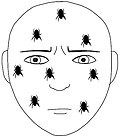Tactile hallucination: Difference between revisions
CSV import |
CSV import |
||
| Line 30: | Line 30: | ||
{{stub}} | {{stub}} | ||
<gallery> | |||
File:Tactile hallucination.jpg|Tactile hallucination | |||
File:Trihexyphenidyl.svg|Trihexyphenidyl | |||
File:Itch 02.jpg|Itch | |||
File:Virtually Painless. Science Museum Painless Exhibition Series.webm|Virtually Painless | |||
File:Schematic of cortical areas involved with pain processing and fMRI.jpg|Cortical areas involved with pain processing | |||
</gallery> | |||
Latest revision as of 01:20, 20 February 2025
Tactile hallucination is a type of hallucination that involves the sensation of touch or movement in the absence of external stimuli. This can include a wide range of experiences, such as feeling bugs crawling on the skin or feeling physical contact from a nonexistent person. Tactile hallucinations are most commonly associated with schizophrenia, substance abuse, and other mental health disorders.
Causes[edit]
Tactile hallucinations can be caused by a variety of factors. They are most commonly associated with mental health disorders such as schizophrenia, but can also be caused by substance abuse, particularly the use of stimulants such as cocaine or methamphetamine. Other potential causes include neurological disorders, sleep deprivation, and certain types of medication.
Symptoms[edit]
The primary symptom of a tactile hallucination is the sensation of touch or movement that is not connected to an external source. This can take many forms, including:
- Feeling bugs crawling on or under the skin
- Feeling as though the skin is being touched or stroked
- Sensations of pressure or movement in the body
- Feeling as though the body is changing shape or size
Treatment[edit]
Treatment for tactile hallucinations typically involves addressing the underlying cause. This may involve medication to treat a mental health disorder, therapy to help manage symptoms, or changes to medication if the hallucinations are a side effect. In some cases, tactile hallucinations may be managed through the use of antipsychotic medication.






